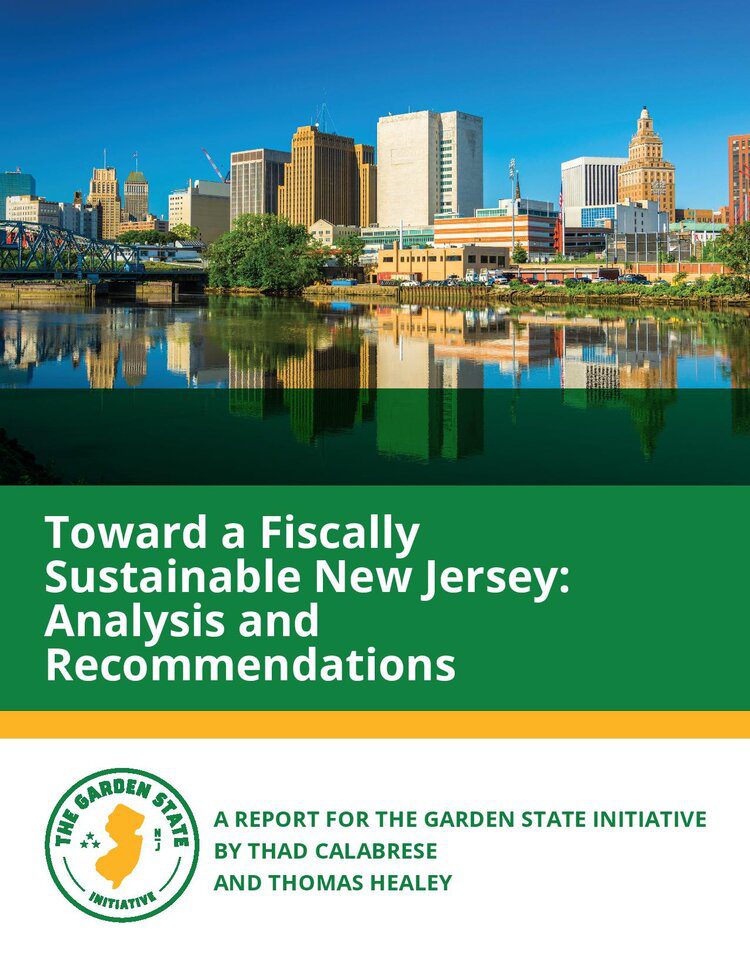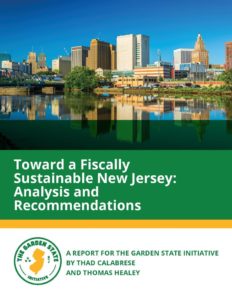Public Spending, ECONOMIC OPPORTUNITY FOR ALL
Toward a Fiscally Sustainable New Jersey: Analysis & Recommendations

Report Examines Failure Over the Last Decade to Address State’s Fiscal Crisis and Offers Policy Recommendations to Reverse Decline
 In a new research report, Toward a Fiscally Sustainable New Jersey: Analysis & Recommendations, the Garden State Initiative examines the lack of progress that has been made in addressing New Jersey’s long-term fiscal crisis outlined in the 2012 State Budget Crisis Task Force analysis by Paul Volcker and Richard Ravitch. The authors of the new report, Thomas J. Healey and Thad Calabrese, Ph.D., write how to change that state’s fiscal course post-pandemic by implementing the kind of bold reforms and measures that can ensure a strong and fiscally sustainable economic future for its citizens and businesses.
In a new research report, Toward a Fiscally Sustainable New Jersey: Analysis & Recommendations, the Garden State Initiative examines the lack of progress that has been made in addressing New Jersey’s long-term fiscal crisis outlined in the 2012 State Budget Crisis Task Force analysis by Paul Volcker and Richard Ravitch. The authors of the new report, Thomas J. Healey and Thad Calabrese, Ph.D., write how to change that state’s fiscal course post-pandemic by implementing the kind of bold reforms and measures that can ensure a strong and fiscally sustainable economic future for its citizens and businesses.
“Having sat in the Governor’s chair I know the difficulties of managing the competing interests when formulating a budget,” said Gov. Thomas H. Kean, who served as New Jersey’s 48th chief executive. “The reality is that the problems detailed in this report are significant and can no longer be ignored. While I commend Gov. Murphy for making the full pension payment this year, the reality is that there is no solution in sight for a year when we do not have federal financial assistance. It is now time to act for the sake of our state’s future.”
“In the last decade, the fiscal challenges faced by our state have not been addressed in any meaningful fashion, in fact, we’ve backslid in several measurable ways,” noted Mr. Healey, the founder and managing partner of Healey Development LLC and Senior Fellow at Harvard University’s John F. Kennedy School of Government. “Our report offers several specific policy recommendations that can reverse this trajectory if our elected officials have the courage to make decisions that reflect the long-term interests of New Jersey. We now need voters to hold those officials to account.”
“Despite the praise surrounding the significant $6.9 billion investment in the pension fund, the state must avoid being lulled into complacency because of one-time Federal COVID financial relief and its $4 billion in borrowing,” added Dr. Calabrese, an Associate Professor of Public and Nonprofit Financial Management at the Robert F. Wagner Graduate School of Public Service at New York University. “New Jersey’s continued success is far from given as our study shows. It is vital that the next state budget does more to help limit the damage and allow for strong economic growth.”
Entering a global pandemic and recession, in 2020 New Jersey’s fiscal condition and economic future were already on an unsustainable trajectory that has since only been exacerbated. Among the key indicators of the state’s decline identified in the report are:
-
NJ has fallen behind the U.S. in job and economic growth: Even though the overall national economy grew significantly during the past decade, New Jersey did not benefit from this national growth. The state’s population and workforce remained flat, a signal that the state was not competitive in attracting people or businesses. During this time, the state budget grew while the population was relatively flat. New Jersey was essentially drawing more resources from its tax base which hindered its business competitiveness.
-
NJ’s revenue is being produced by higher rates on a smaller tax base: New Jersey needs to ensure that the outmigration of high-income residents does not continue. Between 2008 and 2017, New Jersey experienced growth in the number of tax filers of 4.2%; however, growth in those making $500,000 or more annually was only 2.5% during the same time.
-
NJ’s public spending is growing faster than inflation, our population or job creation: Our state will continue to see specific needs increase, especially in public health, health insurance, and public safety. New Jersey already taxes residents and businesses more than most other states. The problem is not too little revenue; rather, it is that the state’s spending is growing at a faster pace than inflation and the state’s population
-
The cost of NJ’s public workforce retirement and healthcare is the key driver of escalating spending and taxes: What New Jersey owes employees and retirees is growing significantly faster than the underlying economy that must support this liability. This is not sustainable. Pension liabilities are growing faster than assets
-
Neglected infrastructure will require more investment: The state has not satisfactorily maintained its physical plant, which likely means that extensive future investments will be necessary just to maintain the existing infrastructure, let alone expand it to meet the new and developing needs. Roadway construction costs are more than five times as expensive in New Jersey than the national average; the state faces six times more expensive acquisition costs, and nearly four times more in engineering costs.
-
New Jersey’s education system is a real strength however costs need to be addressed: K-12 per pupil spending is expensive relative to other states. Specifically, NJ spends 15% more than Massachusetts, which generally receive the same high marks for quality of education as NJ. The cost of educating students has increased faster than inflation even while educating fewer students.
While the overall national economy grew significantly during the past decade, New Jersey did not benefit from this national growth. As noted above, the state’s population and workforce remained flat, a signal that the state was not competitive in attracting people or businesses. During this time, the state budget grew while the population was relatively flat. New Jersey was essentially drawing more resources from its tax base which hindered its business competitiveness. This stagnation has left the state with the urgent need—and promising opportunity—to change its fiscal course post-pandemic by implementing the kind of bold reforms and measures that can ensure a strong and fiscally sustainable economic future for its citizens and businesses. The state needs to avoid being lulled into complacency because of more than $6 billion of one-time Federal COVID financial relief and its $4 billion repayable borrowing.
The report argues in detail that the following critical steps must be taken to place the state on a sustainable fiscal trajectory:
-
Hold the line on taxes in a state where residents and businesses shoulder one of the heaviest tax burdens in the nation. Among the state’s greatest priorities should be ensuring that the outmigration of high-income individuals does not continue. Taxpayers who earn more than $100,000 annually make up about 24 percent of tax returns filed but pay about 86% of all income taxes. As these residents increasingly flee the state, New Jersey faces the daunting prospect of lower income tax revenues and a population unable to support its spending.
-
Work vigorously to reform the state’s ailing public pension and healthcare systems. Elected officials need to continue to pursue options that will address the shortfall while protecting the benefits of those already retired. Among the measures that should be considered are raising the benefit-eligible retirement age of public employees and increasing contributions from employees. Retiree health care programs are also in dire need of change. Reforms might include modernizing the present cost sharing of health care costs between beneficiaries and the state and transitioning to a defined contribution system of health care benefits where retirees are given a predetermined amount of money to purchase whatever benefits they choose.
-
Invest in infrastructure spending to address an estimated $50 billion need over the next decade. NJ ranks at the top nationally for many types of construction costs, which are between four to six times higher than the national average. Infrastructure improvements are critical to economic development and an enhanced quality of life for millions of citizens. Elected officials must find ways to bring these costs down significantly.
-
Refocus spending to achieve a structurally balanced budget relative to revenues that is sustainable over the long-term. Rather than across-the-board cuts, the state should carefully analyze the entirety of its budget to determine which service areas are less critical and what efficiencies could be implemented in these nonvital services in order to protect more vital services and ensure the greatest returns to taxpayers.
Click to listen to a podcast with the authors

